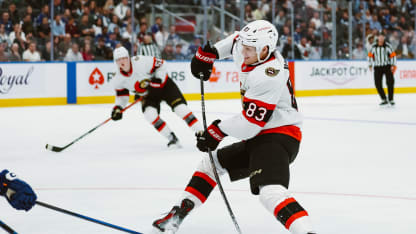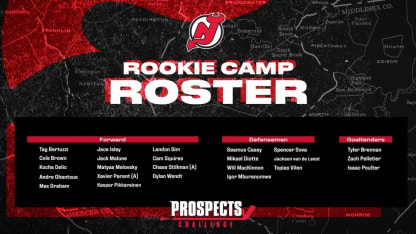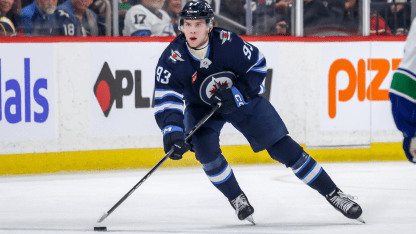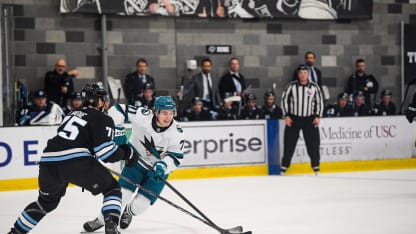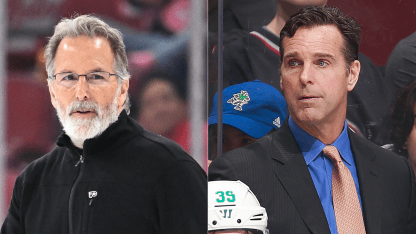TALKING POINTS: Bowman discusses Holloway & Broberg offer sheets
TALKING POINTS: Bowman discusses Holloway & Broberg offer sheets
On Tuesday, Edmonton’s General Manager and Executive Vice President of Hockey Operations spoke to the media about the team’s decision not to match the offer that the Blues made to the forward and defenceman.
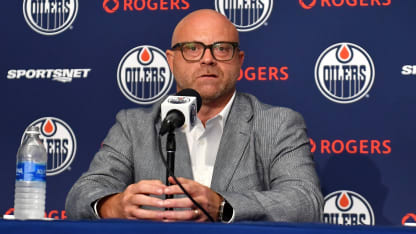
EDMONTON, AB – Oilers General Manager & Executive Vice President of Hockey Operations Stan Bowman held a virtual media availability on Tuesday to discuss the team’s decision to not match the offer sheets presented by the St. Louis Blues to restricted free agent forward Dylan Holloway and defenceman Philip Broberg.
Bowman’s opening comments:
Greetings to all! I’m grateful for your time and acknowledge that there are plenty of queries to address, which I’m more than happy to do. I believe it would be beneficial to begin with our activities since receiving the offer sheets last week. I aim to provide you with insight into our decision-making process, then I’ll be glad to facilitate a question and answer session. So, upon receipt of the offer sheets last week, our team immediately set to work. We focused on our status at that moment, examining every possible option. We didn’t dismiss anything immediately; instead, we explored various paths. Essentially, we identified four potential routes to pursue.
The first option was to match both offer sheets. The second was to match Broberg’s offer but not Holloway’s. Conversely, the third would’ve been to match Holloway’s offer without Broberg’s. The fourth and final option was to reject both offers. We spent a considerable amount of time, spanning several days, analyzing each scenario. We assessed the impact of each option on our team’s immediate future, the upcoming trade deadline and off-season, and even further down the line. Our objective was to envision how our team would fare under each potential outcome and play out all possibilities. Ultimately, we determined the best course of action based on our current standing.
I believe the staff performed exceptionally well. We spent significant time examining and assessing various options. When it came to further investigations, I made numerous phone calls over the past week to most league teams. The aim was to understand their roster plans, whether they intended to let go or add any players. We pursued all available opportunities, but ultimately, we did not match either offer sheet, leading us to our current position.
To simplify, our decision was not a reflection on the players, but rather a business move considering our short-term and long-term financial viability given the salary cap. Once we chose not to match the offer sheets, we knew we would gain assets, which led to further discussions. By managing this situation, we accomplished a few things, giving us flexibility and options for the future, which we felt was crucial.
We didn’t limit ourselves to a single strategy for this season. Instead, we made a series of moves to recruit some young players and secure additional draft picks and prospects. Looking at the overall situation, it’s clear that we were in a difficult position. However, I believe we navigated through it effectively by making the best possible transactions, leaving us in a strong position as we head into training camp.
Stan addresses the media about the offer sheets from Holloway and Broberg.
On having an older team with some veteran free agent additions:
There are several ways to interpret this situation. Clearly, based on how things unfolded, it’s heartening to see that the Oilers have become a preferred choice for players whose main goal is to pursue a championship. While each player is unique and at different stages in their career, it was clear that those who chose to join Edmonton, potentially turning down higher offers, did so because they see potential in our team and want to be part of it. This is a positive development that we hope continues, and it aligns with our team’s objectives. To ensure this continues in the future, we need to maintain a competitive team that attracts players who are intent on winning and see our team as the ideal place for that.
I wouldn’t necessarily assert that we’re exclusively focusing on older players. Indeed, there’s an advantage to having older players, given their extensive experience and exposure to various scenarios, which is valuable. However, we’ve also integrated a few younger players with NHL experience into our organization. These include Podkolzin and Ty Emberson, who are striving to secure their positions as regular NHL players.
This isn’t a situation of choosing one over the other. Having young players in the lineup definitely has its advantages as they bring a unique blend of energy and excitement, mainly because they are new to the NHL or haven’t been around for long. We aren’t against incorporating younger players. In fact, it’s likely to be a mix of both. The crucial factor for players like Podkolzkin and Emberson is their manageable salary cap hits. Considering the current and future state of our team, maintaining salary cap space and flexibility is crucial. Generally, young and veteran players typically have lower cap hits, while those in between tend to have higher contracts.
On the possibility of two younger players dictating the team’s salary cap position:
Returning to my initial remarks, we were assessing our situation when the offer sheets arrived. Considering this and our other constraints, we decided it wasn’t beneficial to limit our future options. It’s not about the players’ skills or talents, but about positioning ourselves for the best possible outcomes. Here in August, we understand that a team’s fortune fluctuates throughout the season, and player performances can be unpredictable. We need the flexibility to adapt as needed. Matching either or both offer sheets would have significantly impacted our salary cap this season and in the future. Thus, we made the decision we did.
On losing two defencemen from last season in Broberg and Cody Ceci:
Indeed, we do have that. We are intent on ensuring that we have a robust defensive strategy in place by the time we reach the final stages. At this juncture, I believe we have numerous options and players who, we are hopeful, will step in and play their part effectively. It’s indeed a fact that our team composition is not the same as it was during Game 7 a few months ago. Consequently, we plan to give them an opportunity to prove themselves, and we also have some new additions to our defense line-up.
Stecher isn’t a newcomer, but he didn’t receive much playing time towards the end of last season. We also have Brown and Emberson, adding up to three players who need to prove their worth and take up more game time. Even though our group has changed, we hope these players can step up and fill larger roles. Another aspect, I’ve mentioned before, is that this situation could allow us to accumulate some salary cap space. If the need arises and we wish to add to our team in the future, this scenario could potentially provide that opportunity.
On the start of contract extension negotiations with Leon Draisaitl:
I anticipated that query, quite naturally given the widespread interest in Leon. I can confirm that we have initiated discussions with Leon and his representative. However, I prefer not to elaborate further. Over the years, I’ve found it’s best to keep such negotiations private, in fairness to both Leon and his agent. This shouldn’t be interpreted negatively in any way. I don’t wish to speculate on a timeline for these talks. We’ve started the process and will certainly update everyone when there are any developments.
On the injury status of Evander Kane heading into the season:
Let me clarify a few details. There seems to be a minor confusion about how the process works with regards to injured players, long-term injury, and how their cap hit is replaced, among other things. I’ll attempt to provide a concise explanation here. When a player, such as Evander in this instance, is injured, their future course of action is determined by the player and the doctors. I don’t have any influence over that, and it isn’t my place to. My primary concern is to support Evander and ensure his recovery.
In case of an injury, several options emerge. These include treatment and rehabilitation until the player recovers and is fit to return to the game. Sometimes, immediate surgery is the only clear solution for certain injuries. However, there are also injuries that are not so clear-cut and offer multiple treatment paths. Ultimately, the decision rests with the player, and we fully support Evander in this regard. Currently, we find ourselves in this third scenario. Thus, it’s uncertain if he will miss a part or a longer duration of the season due to possible surgery. We lack this information presently, and I don’t make those decisions. He will consult with the doctors to determine his next steps.
The relevance of this topic to our discussion is the misconception that if a player is injured, they can simply be placed on long-term injury leave and there’s no need for trading or concern. This is not entirely true because the player’s salary still affects the team’s cap. They will either be part of the regular team cap after coming off LTI or, if they will be out for more than 24 days or 10 games, they can be placed on long-term injury. However, a plan should be in place to activate them when they return. This aspect was a significant part of our discussions. While it may be possible to start the season with a player on long-term injury if they’ll be out for at least a month, it becomes challenging when planning for their return to play.
I’d like to point out that no cap space is accumulated during a long-term injury. Hence, if a player is on long-term injury for a certain period and then becomes active, you start with no cap space and need to build it up from scratch. Therefore, you won’t manage to accumulate much in just a month or so. All these factors were considered in our decision-making process. As it stands now, we will commence the season with Evander Kane not on any form of injury list, just like the rest of the team. If he’s fit to play immediately, that’s excellent. Otherwise, we won’t have any difficulty accommodating him once he’s fit.
On the additions of Vasily Podkolzin, Ty Emberson and Paul Fischer:
To provide some background, I can discuss the three players in question. When faced with situations like the one we encountered last week, we typically engage our entire staff and leverage any connections they may have with the players we’re discussing with other teams. For example, in Emberson’s case, I had a conversation with Kris (Knoblauch). Kris is well-acquainted with Ty and spoke highly of his gameplay. He enjoyed having Ty as part of his Hartford team, where Ty proved to be a valuable player. It’s always beneficial when there’s a pre-existing rapport between a coach and a player we’re considering to bring in, although this isn’t always the case, especially if they’ve been coached by them in different teams. I believe this was an advantageous factor in this scenario.
Clearly, Podkolzin was a top selection, being the 10th overall pick, so he has a strong background. He had a promising rookie year in the NHL, but his performance hasn’t been the same since then. Most of his time has been spent in the American League, and there have been regime changes there. We’ve all seen how some players, for various reasons, struggle to adapt when things change. This isn’t meant to criticize anyone. Often, it’s not the fault of the player or the situation. However, I appreciate Podkolzin’s comprehensive skill set, as he clearly has scoring potential. He has a powerful shot and is a strong player. He’s a direct, physical player, which I noticed and appreciated – his readiness to engage. He’s robust and forceful, capable of playing a possession-style game in the offensive zone, and when he doesn’t have possession, he’s not afraid to tackle opponents. I found this combination quite impressive and there’s hope that we can help him regain his early form, not just from his draft year, but from his first professional year. It’s now up to our coaches and team to help him reach his potential. Sometimes, a fresh start can be beneficial for players like him.
I’ve known Paul Fischer for a significant amount of time. He was raised in Chicago and I’ve observed him since his early days, participating in countless games over the years. He even made it to the U.S. national team, showing remarkable progress. Unfortunately, an injury during his draft year affected his standings, but his talent level was undeniably high. I continued watching his growth last year at Notre Dame, where he proved himself as a freshman defenceman and played a substantial role on the team. He’s also a strong contender for the U.S. World Junior team.
Paul’s skill set makes him a very appealing player. He has a good physique and a blend of qualities that make him stand out. Despite his youth and areas needing improvement, he has a strong character and is committed to enhancing his game.
It’s encouraging to see him as part of our plan to strengthen our group. Player development is a priority for us, and we’re investing a considerable amount of time in it. Our aim is not only to identify promising young prospects like Paul but also to expedite their growth and development so they can make it to the NHL sooner.
On Bowman’s initial reaction to receiving two offer sheets from the same team:
Undeniably, it was a considerable challenge. Offer sheets are rarely seen, let alone two at the same time. I believe my response was to simply buckle down and get to work. After the offer sheets are in, I can see why the media and fans might spend a lot of time on other matters, but I wasn’t caught up in that. My focus was on the future. We now have a decision to make. We’re faced with a complex problem that we need to solve. It was definitely a tough task to find the best solution. However, considering the entire scenario, I am confident that I managed it as effectively as possible, providing us with several options for the future.
On whether he harbours any negativity towards the Blues after the offer sheets:
I believe it’s important to distinguish between professional and personal matters. My acquaintance with Doug Armstrong spans over many years. We’ve faced numerous challenges together when I was in Chicago and he was still based in St. Louis. However, I don’t perceive it from a personal perspective. I comprehend that every manager has the potential to utilize such situations, and it’s our duty to respond appropriately and act in our best interest. Personal emotions shouldn’t obstruct such processes. It’s crucial for us to maintain a professional relationship with all the managers in the league, and I plan to continue doing so.
On the possibility of targeting any more players between now and the start of the season:
At this juncture, nothing is ruled out. I believe it’s not beneficial to shut any possibilities now. Perhaps, I should have made it clear earlier that we have some new members that deserve a chance. They joined us for a reason. For instance, Emberson, who we recently traded for. We aim to give them a platform to prove their potential and be valuable to us. However, it’s also my duty to explore the options available to us, be it via more trades or current free agents. I plan to do so, although I can’t guarantee it will result in anything. The constraints remain the same. Our salary cap situation remains unchanged, so we’ve been mindful to retain some leeway going forward. But to answer concisely, yes, we definitely have the ability to engage with players and identify if there’s anyone worth recruiting.


